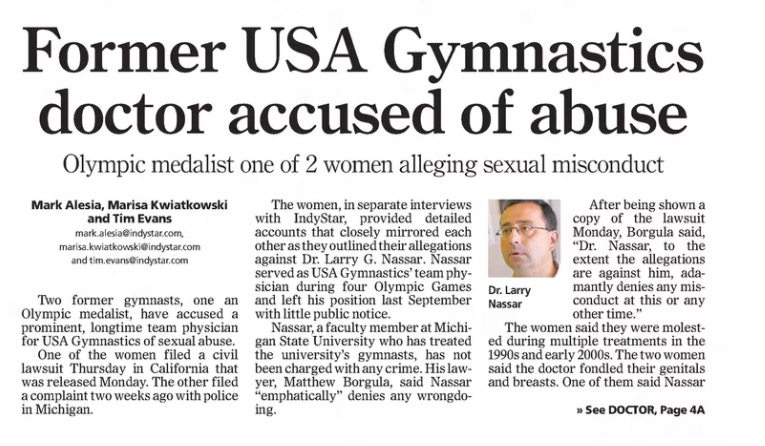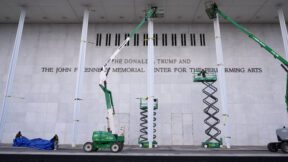How the Fourth Estate Helped Finally Bring Larry Nassar to Justice — Where Others Failed

Front page of the Indianapolis Star, September 13, 2016
This week a series of American gymnasts delivered powerful testimony before Congress about the sex crimes of Larry Nassar, who is serving a life sentence for sex crimes that include molesting hundreds of girls and women while serving as the USA Gymnastics team doctor.
Olympic gold medalist Simone Biles and other teammates, including McKayla Maroney, Aly Raisman and Maggie Nichols, described in heart-wrenching testimony the toll that Nassar’s abuse took, and the institutions that shielded him, including the FBI, which was shamefully slow to investigate allegations against him.
“I blame Larry Nassar and I also blame an entire system that enabled and perpetrated his abuse,” Biles said.
The FBI was investigating Nassar as early as July 2015. Maroney, who said she was abused for “hours” by Nassar at the Tokyo games, described the attack to an FBI agent at the time.
According to the New York Times:
McKayla Maroney, an Olympian in 2012, also testified, describing in detail how Mr. Nassar repeatedly abused her, even at the London Games, where she won a gold medal. She said she survived a harrowing ordeal when she and Mr. Nassar were at a competition in Tokyo, certain she “was going to die that night because there was no way he was going to let me go.”
“That evening I was naked, completely alone, with him on top of me, molesting me for hours,” she said.
In 2015, when Ms. Maroney was 19 years old and before she had even told her mother what Mr. Nassar had done, she described her abuse to an F.B.I. agent during a three-hour phone call from the floor of her bedroom. When she finished, Ms. Maroney said the agent asked, “Is that all?” She said she felt crushed by the lack of empathy.
“Not only did the F.B.I. not report my abuse, but when they eventually documented my report 17 months later, they made entirely false claims about what I said,” Ms. Maroney testified. “They chose to lie about what I said and protect a serial child molester rather than protect not only me but countless others.”
As the FBI investigation plodded along with little urgency, Nassar continued to molest young women. According to court records, 70 or more women and girls were allegedly abused between July 2015, when he was first reported to the FBI, and September 2016.
What happened in September 2016: An Indianapolis Star report on allegations of abuse against Nassar, part of an investigation into misconduct at U.S.A. Gymnastics, which is based in Indianapolis, was published.
In the report, two gymnasts — Rachael Denhollander and another who remained anonymous — accused Nassar of abuse. It was that report, and an ensuing, years-long investigation, that eventually led to the arrest of Nassar.
The timeline of events, and how the Star’s reporting brought the abuse public, is described in the Justice Department’s inspector general report on the FBI’s handling of the case:
In August 2016, the Michigan State University Police Department (MSUPD) received a separate complaint from a gymnast who stated that she was sexually assaulted by Nassar when she was 16 years old. Two weeks later, The Indianapolis Star ran a news story describing sexual assault allegations against Nassar by former gymnasts. The MSUPD then received similar sexual abuse complaints against Nassar from dozens of additional young females, and, on September 20, 2016, the MSUPD executed a search warrant at Nassar’s residence and discovered child pornography.
As a result of the news stories and MSUPD investigative activity, the FBI’s Lansing Resident Agency first learned of the Nassar allegations and opened its Nassar investigation on October 5, 2016 (neither the FBI’s Indianapolis Field Office nor the FBI’s Los Angeles Field Office had previously informed the Lansing Resident Agency of the Nassar allegations). The Lansing Resident Agency ultimately discovered over 30,000 images of child pornography on the devices seized by the MSUPD during its search of Nassar’s residence.
The September 2016 news reports and MSUPD investigative activity also resulted in Nassar being removed from his positions at MSU, Twistars USA Gymnastics Club, and Holt High School. According to civil court documents, approximately 70 or more young athletes were allegedly sexually abused by Nassar under the guise of medical treatment between July 2015, when USA Gymnastics first reported allegations about Nassar to the Indianapolis Field Office, and September 2016. For many of the approximately 70 or more athletes, the abuse by Nassar began before the FBI first became aware of allegations against Nassar and continued into 2016. For others, the alleged abuse began after USA Gymnastics reported the Nassar allegations to the Indianapolis Field Office in July 2015.
As the New York Times reporter Daniel Victor wrote in 2018, in an ode to the Star’s reporting, “The decision of the newspaper to spend on airfare to follow a lead, then throw themselves behind an investigative project that has now continued for nearly two years, led to the arrest and sentencing of Lawrence G. Nassar.”
The tragedy is that local news is in dire straits. What did the Indianapolis Star get for producing some of the most important journalism in America since the reporting of the Catholic Church abuse scandal? Layoffs. Buyouts. Paycuts.
The media takes a lot of heat from the pundit class, but the consequences of the vital reporting pursued by the Star should serve as a reminder of the urgent importance of local news.





Comments
↓ Scroll down for comments ↓